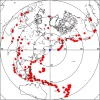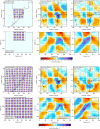Deep magma sources beneath Central Kamchatka inferred from teleseismic tomography
- PMID: 40368991
- PMCID: PMC12078557
- DOI: 10.1038/s41598-025-01298-3
Deep magma sources beneath Central Kamchatka inferred from teleseismic tomography
Abstract
Central Kamchatka is a typical Andean-type subduction complex including a linear volcanic arc, back-arc volcanic complexes and zones of tectonic shortening and extension. With the use of teleseismic tomography, we investigate the role of mantle processes in the observed volcanic and tectonic activity in this region. We use the seismic data of permanent stations and a temporary network deployed in central Kamchatka in 2019-2020. Arrival times of the P waves from events at distances from 15 to 110 degrees are used as input for tomographic inversion to derive a 3D model of the P-wave velocity anomalies down to the depth of 150 km. In the resulting model, beneath the central part of the study area, we observe a prominent low-velocity anomaly in the mantle overlain by a high-velocity crustal block. A chain of the Avacha Group volcanoes is located above the northeastern border of this anomaly, and Mutnovsky, Gorely and Viluchinsky volcanoes are associated with its southwestern border. We propose that the hot mantle material, which arrived from the slab window, surrounds the bottom of the rigid crustal block and ascend along its borders causing the formation of large stratovolcanoes.
© 2025. The Author(s).
Conflict of interest statement
Declarations. Competing interests: The authors declare no competing interests.
Figures









References
-
- DeMets, C., Gordon, R. G., Argus, D. F. & Stein, S. Current plate motions. Geophys. J. Int.101(2), 425–478 (1990).
-
- Holocene Kamchatka volcanoes. http://www.kscnet.ru/ivs/volcanoes/holocene/main/main.htm (2024).
-
- Melekestsev, I. V., Litasova, S. N. & Sulerzhitskii, L. D. The age and scale of catastrophic eruptions of the directed explosion type in the Avacha Volcano (Kamchatka) in the Late Pleistocene. Volcanol. Seismol.13(2), 135–146 (2009).
-
- Dobretsov, N. L., Koulakov, I. Y., Litasov, K. D. & Kukarina, E. V. An integrate model of subduction: contributions from ge-ology, experimental petrology, and seismic tomography. Russ. Geol. Geophys.56(1–2), 13–38 (2015).
-
- Steinberg, G. S. & Zubin, M. I. The depth of the magmatic focus under the Avachinsky volcano. Dokl. Akad. Nauk SSSR152(4), 968–971 (1963).
Grants and funding
LinkOut - more resources
Full Text Sources

